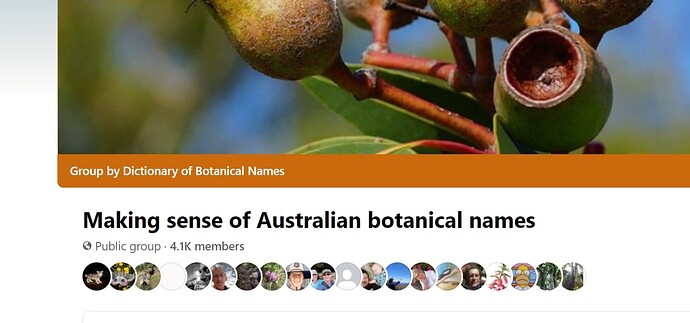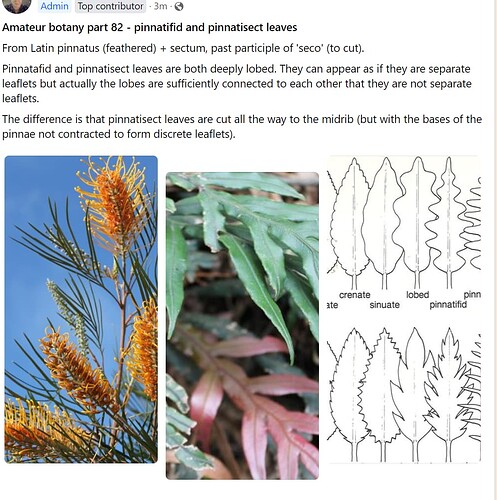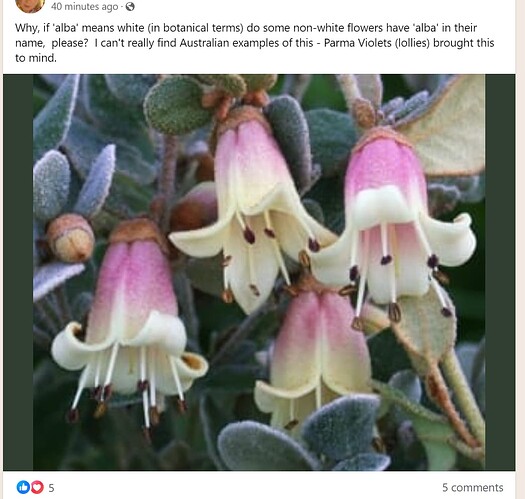so do I: I’m a member of over 20 Australian Facebook ID groups, covering pretty much all taxa, and the general public have no issues with taxa with scientific names only. So maybe it’s a regional thing, but Australian users, on FB and iNat, seem to have no qualms whatsoever with scientific names only
(Sorry for the tangent)
That’s great! My local native plants group is full of discussions on the medical benefits of invasive Verbascum or the terrible sticky seeds of native Lappula. ![]()
maybe the solution is for each region to have one of these ;)
certainly helps to ‘demystify’ scientific names for the general public, and encourage them to learn more
Yes.
Not so much, if by “answered” you mean that there is a clear, consistent consensus anchored by policy. The bit about not making up names on iNat is mostly established. The bit about what constitutes use, on the other hand, is a dog’s breakfast with ridiculous, boring and stupid names accepted if published once in a lower tier academic journal by some grad student somewhere with no more credibility as a source of novel names than anybody else and regionally established vernacular names excluded because, apparently, some folks will be led astray by them. The latter point would be more persuasive if there were evidence of an effort to standardize the application of words like trout and warbler, but no such evidence exists.
So here’s a suggestion, if iNat is not an appropriate venue for creating names it should also not be a venue for expunging existing, established names. Vernacular is confused and confusing sometimes and it is not up to iNat to police that.
or the terrible sticky seeds of native Lappula.
and ^ this ^, seems to be how I find where to start looking for an ID for maybe up to half of the things that I really don’t know where to even start looking :D Stumbling on some “random” reference to something that makes my brain go ‘wait, that seems familiar’ …
I have one of these (or at least a close relative to it) in my yard - and since I didn’t plant it and since it doesn’t grow things I can eat, it lives in that subset of things I mostly just leave to its own devices. If it belongs there, the General Mish Mash will support its needs and those of the things that need it.
I’d always just assumed it was a forget-me-not, but recently a friend assured me that wasn’t the case, and that it was instead all-too-well known by its common name of “Sticky blue shit”. She didn’t know its binomial, and that’s not a phrase google is at its best for, so learning more about that quickly went to the back burner again.
I don’t know who made up that name, or how regional it is, but without it I probably wouldn’t have made the connection to your description, so I think it gets my tick as One Of The Good Ones, whatever its provenance :)
What should you do in cases where there are hundreds of made-up common names, like has happened with jumping spiders? Flagging them all for curation doesn’t seem like a scalable solution, but mass deleting them may also be controversial. Any advice?
I’ve recorded something like 1,300 species, and the only one I am aware of that does not have a common name in English was this weird bug that I photographed because it looks like it is wearing tiny socks: https://www.inaturalist.org/observations/226046607 I am not at all resistant to recording species that lack a common name, I just haven’t encountered many yet.
I suspect it depends on where you live and what you are interested in. There are zero birds in North America that don’t have common names, and not very many wildflowers, butterflies, or dragonflies.
So my person guess is that we simply don’t know if people are less likely to report species that don’t have common names, because many people are less likely to observe those species in the first place. (Personally, I have my interests, but I will report anything that I think there’s a chance of identifying. Hence the bug with tiny socks.)
I am fully in favor of staff updating the curator guidelines to be more stringent about what qualifies as a common name (including exclusion of the previously mentioned government lists & their questionable common names as justifications for common names), because there are a lot of pointless back-translation common names on iNat that aren’t actually used by laypeople.
Many common names (English and Spanish) i see for Caribbean species are inventions that have never been used before, and were especially invented for iNat.
Inventing and uploading a new name on iNat can be done very fast and doesn’t need any source citation. On the other hand, correcting a invented name is a lenghty process as one needs to inform curators and show the lack of use for these invented names…
I see only two solutions
- continue as before and find peace with the fact that iNat is and will be the source of many invented names.
- make invention of common names on iNat more difficult, e.g. by informing regular users that inventing common names is not permited / requiring at least one source / or by implementing a review process before adding common names to the database.
Updating the curator guidelines is certainly a step, but in the Caribbean it’s regular users that invent most names… so it’s certainly not enough to move from scenario 1) to 2).
Sources are already required to add a new name to iNaturalist. This is a fairly recent change, meaning that many old names exist without them, but all new names added now are required to include a source.
Geography and personal interest certainly have an influence on the likelihood of a user uploading organisms without an English common name. Of my five most-observed species, only one of them has an English common name. Narrowing things down to just spiders - which I enjoy photographing - from my ten most-observed species, only three have English common names; similarly, only fourteen from my top fifty most-observed spider species have English common names.
I have my doubts that most people are purposefully not photographing and/or uploading organisms because they don’t have an English common name. My experience is that there are many users who don’t know what it is they’ve observed - posting on iNaturalist preceisly to learn that information - meaning the presence or absence of a common name is kind of a moot point. The main exception that comes to mind are folks who don’t photograph/upload a type of organism because they know from experience that it’s unlikely to be identified to species (or whichever taxonomic level that they want).
There are probably less than 10 species of Chironomid with a common name out of over 5000 species. Yet on the site there are over 140k observations of Chioronomid.
But are users satisfied with their IDs? Or do they just go “oh” and kind of move on. Common names make the natural world much more accessible.
People should be satisfied when they know their IDs are correct. Most other users IDs are incorrect from people using what the CV recommends. In fact, the few common names on the site have caused more miss identifications and issues than they have helped at all. None of the common names are applied to easy to ID common species. There are more Chironomids with common names that have 0 observations than there are ones with observations.
I’m constantly having to correct miss identifications. What good is a common name if practically every observation IDed as it is pushed up to a higher taxon, or IDed as something else because it is wrong, or not possible to ID the species. That is the situation with the “Winnebago Lake Fly” Chironomus plumosus. Somehow a species that requires DNA analysis to ID in North America, and microscopic imagery of the genitalia elsewhere has 11 common names. It’s actually ridiculous, and it is a constant stream of miss identifications that I have to keep up on, otherwise they start piling up.
This is not IDable to even genus. https://www.inaturalist.org/observations/231626979
We encountered a case when processing a flag, I guess it might be worth discussing here:
I suspect that the Chinese name “卧地梅属” of Douglasia was made up by an unethical botanist by 2010s. He created a lot of names starts with “卧” for herbs to implicitly express “卧草”, which was admitted by himself in a lecture.
I’ll give an explanation for users who may not understand Chinese: The Chinese word “卧草” (wò cǎo) literally means “lying herbs”, but it sounds like another Chinese word “我肏” (wǒ cào) which means “I fuck”. Since the latter is not allowed on the Chinese Internet, the former is often used as an alternative.
These names are now accepted by some Chinese plant databases including iPlant (Operated by the Institute of Botany, Chinese Academy of Science). Should we use them on iNaturalist?
If the usage is there, and there are authorities accepting the name, then I see no reason not to include it, even if the origins are a bit silly.
Orange Atoms actually comes from a field guide printed in Colorado which has made common names for many of the lichens in the area! Several are quite strange I will say, but I actually rather enjoy the creativity of some (like orange atoms). Though im sure no one would be opposed to that one being made a secondary common name in favor of one used in more text.
Otherwise I think it could be nice to make a way to on name pages easily see sources added for said species. A unique type of flags pertaining to common names could also be useful in solving name disputes.
You can already see listed sources for common names using the “history” tab on a taxon page.
It seems to me that, when it comes to iNat, the primary concern is about dissemination, correct? If Example exampelii has no English common name, then someone finds “brown butter toot fly” for it on Wild Species Canada and adds that name to the species on iNat, “brown butter toot fly” is now the name that is “officially” displayed to all, which is bad?
If so, one potential solution would be some way to denote that a name is helpful for search but shouldn’t be a display name, and a curator could choose a display name. So someone familiar with “brown butter toot fly” from a site like Wild Species Canada could find the right species, but the name wouldn’t be prominently displayed on the observation page or taxon page. That wouldn’t solve the search results issue, but I think it would reduce the problem.
Another option would be to keep name submission open to any user but the name must be approved by a curator. That’s something I’ve wanted for a long time, but it might just be too much work for curators.
Seems like that’s probably not a good source of names, or at least they shouldn’t be rotely copied from that list. However, making up some sort of official list of sources that shouldn’t be used on iNat seems like an impossible task for a global platform like this one, so I’d be wary of starting one with Wild Species Canada.
FWIW, that stemmed from a very early case on iNat where someone did something like add the name “snail” to every snail species that lacked a common name.
Yes, I think this is the correct way to look at it.
I’m pretty sure most people are motivated to record something when they find it interesting, not whether or not they know it has a common name. People use iNat often because they don’t know the name of something, so whether not is has a common name is not part of the decision-making process.
I feel this. Many of my friends speak only in binomials in the field and I have have to be reminded of what they’re referring to. However, that doesn’t mean that adding any name in existence to iNat is an inherently good thing.


